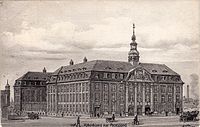| Copenhagen Central Post Building | |
|---|---|
 Main facade toward Tietgensgade | |
 | |
| General information | |
| Architectural style | Baroque Revival |
| Town or city | Vesterbro, Copenhagen |
| Country | Denmark |
| Construction started | 1909 |
| Completed | 1912 |
| Cost | DKK 2.5 mio. |
| Client | Danish Post and Telegraph Company |
| Design and construction | |
| Architect(s) | Heinrich Wenck |
Copenhagen Central Post Building (Danish: Centralpostbygningen), located on Tietgensgade, just behind the Central Station, in the Vesterbro district of Copenhagen, Denmark, was originally built as a new headquarters for the Danish Post and Telegraph Company and now houses Villa Copenhagen, new luxury hotel planned to open April 2020.
The building was designed in Neo-Baroque style by Heinrich Wenck, who also designed the Central Station, and completed in 1912.
History
[edit]
The Danish Mail Services traces its history back to 1624 and it was based in Mail Building in Købmagergade from 1779.[1] When those premises became too small, in about 1900, it was decided to build a new headquarters next to the new Central Railway Station and not far from the new City Hall which was completed in 1905. Chief architect of the Danish State Railways, Heinrich Wenck, who had also designed the new central station, was charged with the commission and the new central post building was constructed from 1898 to 1812.
Architecture
[edit]The Central Post Building is designed in Neo-Baroque style, one among several styles which, as a reaction to the dominance of Historicism in Danish architecture, won popularity in the beginning of the 20th century in Denmark.
See also
[edit]References
[edit]- ^ "Palatial Mansions in Copenhagen". Astoft. Archived from the original on 2011-05-27. Retrieved 2011-04-15.

Well, that’s interesting to know that Psilotum nudum are known as whisk ferns. Psilotum nudum is the commoner species of the two. While the P. flaccidum is a rare species and is found in the tropical islands. Both the species are usually epiphytic in habit and grow upon tree ferns. These species may also be terrestrial and grow in humus or in the crevices of the rocks.
View the detailed Guide of Psilotum nudum: Detailed Study Of Psilotum Nudum (Whisk Fern), Classification, Anatomy, Reproduction